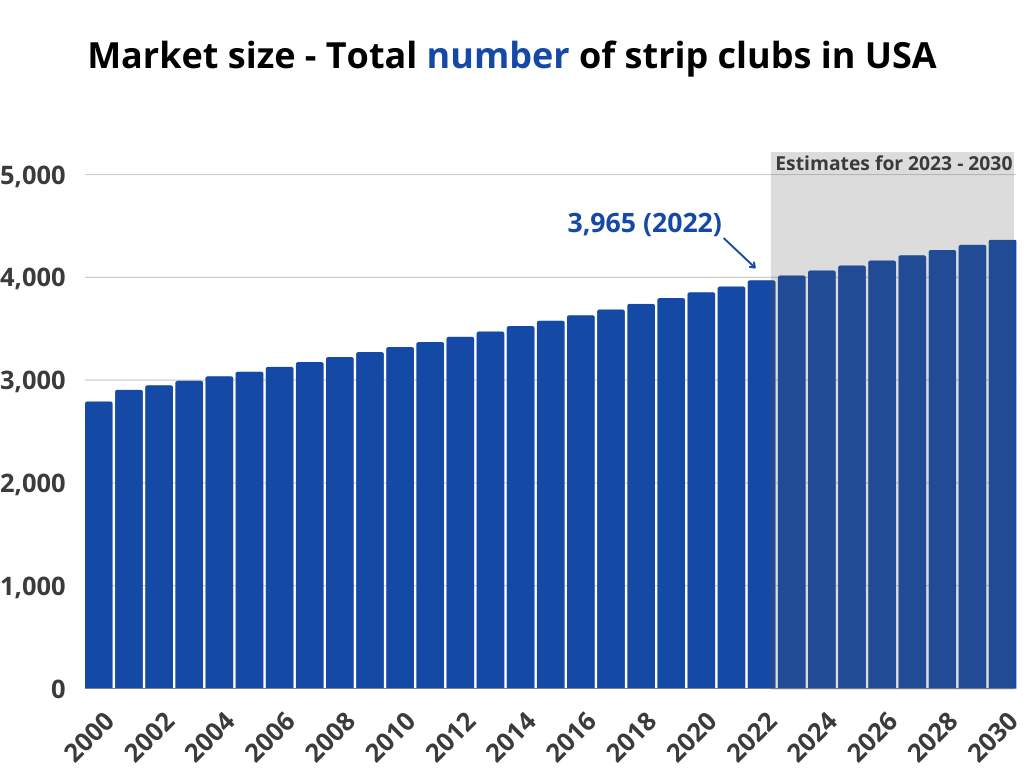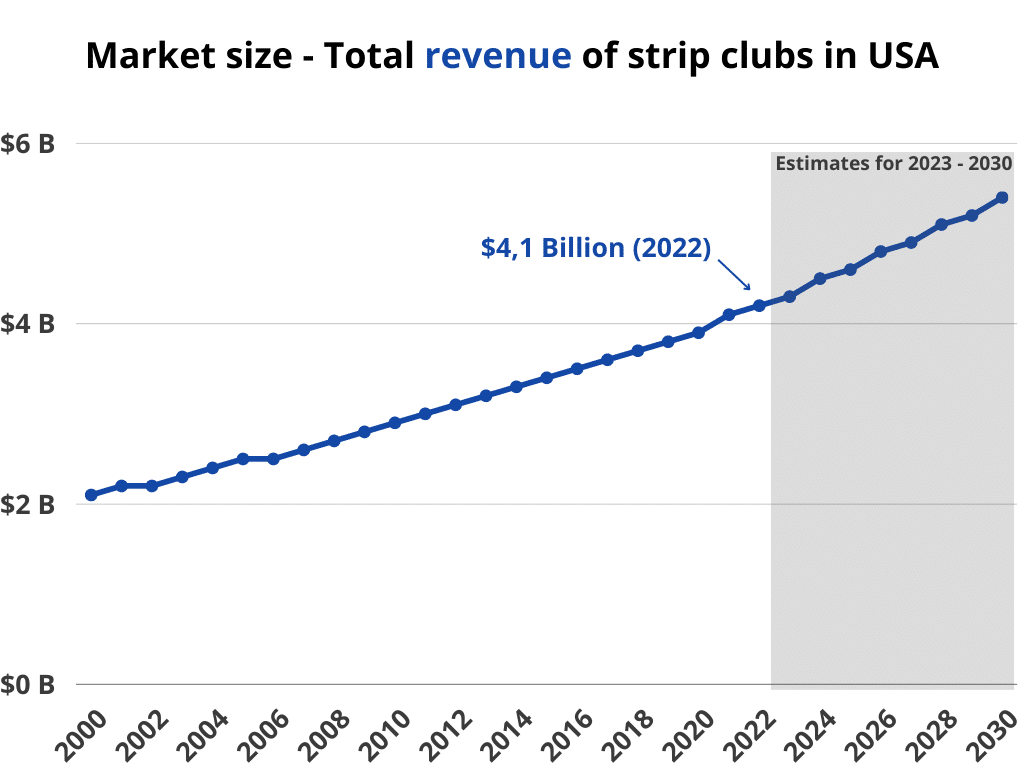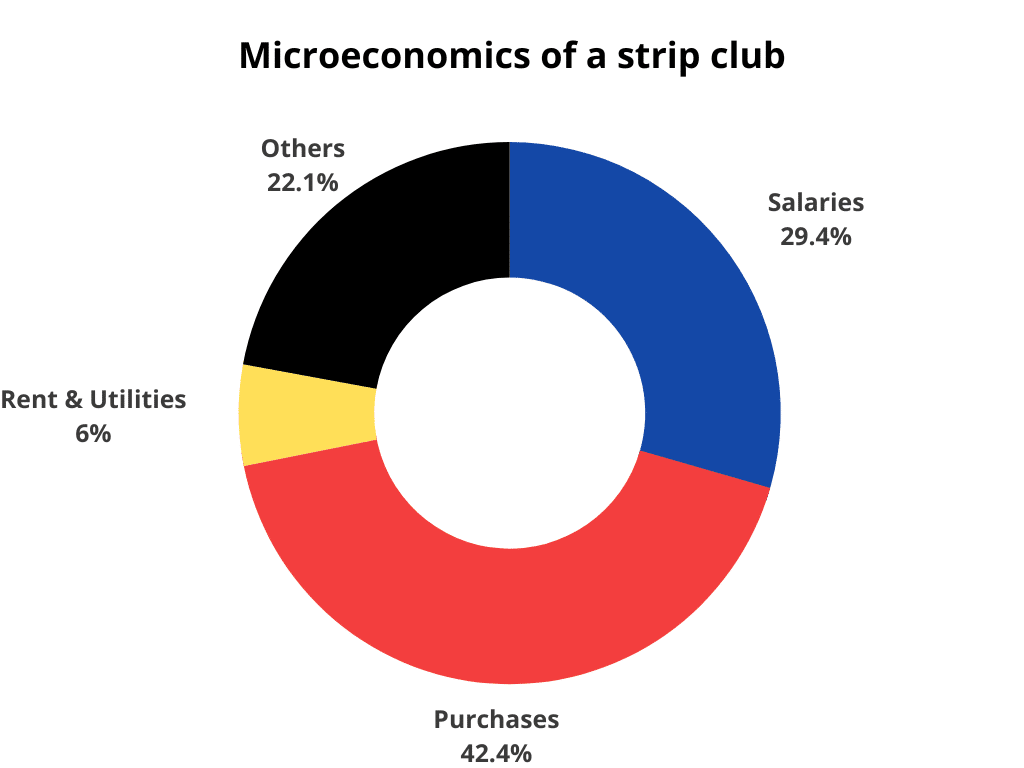![Strip Club Industry Statistics [Market Report]](https://wp.bedbible.com/wp-content/uploads/2023/03/Strip-Club-Industry-Statistics-and-Market-Report.png)
Ladies and gentlemen welcome to a revealing exploration of the Strip Club Industry Statistics.
From the neon-lit stages of Las Vegas to the hidden corners of your city’s downtown, we will be delving into the numbers that keep this intriguing industry thriving. Get ready to uncover the economics behind the glitter and the glamour, as we take a closer look at the financial and social aspects of this unique market.
Whether you’re a curious outsider or an industry insider, prepare to be dazzled by the tantalizing statistics that make the Strip Club Industry a force to be reckoned with.
We’ve explored these topics:
Key Findings
- There are around 3,965 strip clubs in the US.
- The strip clubs generate around $4,1 billion in revenue pr. year.
- 19.5% is the average decline in revenue that all strip clubs had due to the pandemic.
- 3.2% is the CAGR in which the industry is expected to increase in terms of revenue pr. year from today to 2030.
- The number of strip club locations is expected to decrease by 1.2% pr. year to 2030.
- The industry employs around 75,000 people in the US; including management, dancers, owners, bartenders, etc.
- Portland is the city with the most strip clubs in the US with 53. That’s 1.92 strip clubs pr. 100,000 inhabitants (Las Vegas has 42 gentleman clubs).
- In the United States, exotic dancers have the potential to earn between $40,000 to upwards of $100,000 annually.
- At certain high-end strip clubs, the cost of admission may vary from approximately $20 to exceed $100.
- Owners can earn anywhere from $50,000 to over $500,000 per year.
- The strip club with the highest revenue and the most market share in the US is Sapphire Gentlemen’s Club in Las Vegas with $80 million and a 5% market share.
- Michael Ocello is the highest net worth strip club owner in the US with an expected net worth of $1,4 billion. He owns the strip club called Scores.
- This is the breakdown of the microeconomics of a US strip club: 29.3% of revenue is allocated to salaries, 42.2% to purchases, 6% to rent and utilities, and the remaining 22.5% is designated for other expenses.
Market size and trends
This section of the market report provides an in-depth analysis of the market size and trends within the strip club industry in the United States. We present key statistics, facts, and numbers that help to illustrate the current state and trajectory of the industry.
Market Size
- The strip club industry in the United States was estimated to generate annual revenues of around $4.1 billion.
- Approximately 3,965 strip clubs are operating across the country, with a significant number of these being independently owned and operated establishments.
- The industry is anticipated to grow at a Compound Annual Growth Rate (CAGR) of 3.2% per year from today until 2030.


Industry Trends
- The strip club industry has experienced a decline in growth, with the number of establishments decreasing by approximately 1.2% annually.
- The industry has witnessed a shift in consumer preferences, with high-end gentlemen’s clubs gaining popularity among affluent clientele, while smaller establishments face increasing competition from online adult entertainment sources.
Employment
- The strip club industry employs an estimated 75,000 people in the United States, including exotic dancers, bartenders, security personnel, and management staff.
- Exotic dancers in the United States can earn anywhere from $40,000 to over $100,000 per year, depending on factors such as the club’s location, clientele, and the dancer’s popularity.
Impact of the COVID-19 Pandemic
- The COVID-19 pandemic had a significant impact on the strip club industry, with many establishments temporarily or permanently closing due to lockdown measures and social distancing requirements. During this period, some clubs pivoted to virtual or drive-thru services to maintain revenue streams.
- As the economy recovers and restrictions are lifted, the strip club industry is expected to experience a resurgence in demand, although the growth rate may be tempered by the increased adoption of online adult entertainment platforms during the pandemic.
- During the pandemic, strip clubs experienced a significant financial impact, with an average decline in revenue of 19.5% across the industry. This downturn was primarily due to lockdown measures, social distancing requirements, and reduced consumer spending on leisure activities, all of which contributed to the challenging business environment faced by these establishments.
Future Outlook
- The strip club industry is expected to see modest growth in the coming years, with high-end establishments and niche experiences likely to fare better in the market. The industry will continue to be influenced by evolving social norms, regulations, and competition from digital platforms.
- Technological innovations such as virtual reality (VR) and augmented reality (AR) have the potential to reshape the strip club experience, offering immersive and interactive adult entertainment options that could drive growth in the industry.
Strip Club Density
- The states with the highest concentration of strip clubs per capita are Oregon, Nevada, and West Virginia. These states have a relatively lax regulatory environment and a higher acceptance of adult entertainment.
- The city with the highest number of strip clubs per capita in the United States is Portland, Oregon, with approximately 54 strip clubs for a population of around 653,000.
| Rank | City | Strip Clubs pr. 100K Population |
|---|---|---|
| 1 | Portland, OR | 1.92 |
| 2 | Tampa, FL | 1.49 |
| 3 | New Orleans, LA | 1.18 |
| 4 | Virginia Beach, VA | 1.13 |
| 5 | Louisville, KY | 1.11 |
| 6 | Jacksonville, FL | 1.06 |
| 7 | Las Vegas, NV | 0.96 |
| 8 | Cleveland, OH | 0.92 |
| 9 | Miami, FL | 0.90 |
| 10 | Baltimore, MD | 0.89 |
| 11 | Houston, TX | 0.84 |
| 12 | Oklahoma City, OK | 0.79 |
| 13 | Milwaukee, WI | 0.76 |
| 14 | Charlotte, NC | 0.75 |
| 15 | Detroit, MI | 0.74 |
| 16 | Indianapolis, IN | 0.74 |
| 17 | Philadelphia, PA | 0.74 |
| 18 | Pittsburgh, PA | 0.69 |
| 19 | Tucson, AZ | 0.68 |
| 20 | Columbus, OH | 0.67 |
| 21 | Salt Lake City, UT | 0.67 |
| 22 | New York, NY | 0.66 |
| 23 | Richmond, VA | 0.63 |
| 24 | Providence, RI | 0.62 |
| 25 | Los Angeles, CA | 0.62 |
| 26 | Memphis, TN | 0.60 |
| 27 | Phoenix, AZ | 0.59 |
| 28 | St. Louis, MO | 0.57 |
| 29 | Austin, TX | 0.57 |
| 30 | San Antonio, TX | 0.57 |
| 31 | Dallas, TX | 0.55 |
| 32 | Buffalo, NY | 0.53 |
| 33 | Atlanta, GA | 0.48 |
| 34 | Birmingham, AL | 0.46 |
| 35 | Raleigh, NC | 0.45 |
| 36 | Orlando, FL | 0.44 |
| 37 | San Diego, CA | 0.42 |
| 38 | Denver, CA | 0.42 |
| 39 | Hartford, CT | 0.41 |
| 40 | Minneapolis, MN | 0.39 |
| 41 | Kansas City, MO | 0.38 |
| 42 | Rochester, NY | 0.37 |
| 43 | Chicago, IL | 0.33 |
| 44 | Washington DC | 0.31 |
| 45 | Seattle, WA | 0.28 |
| 46 | San Jose, CA | 0.25 |
| 47 | Boston, MA | 0.25 |
| 48 | Cincinnati, OH | 0.23 |
| 49 | San Francisco, CA | 0.21 |
| 50 | Riverside, CA | 0.20 |
How much do strip club owners make?
This section of the market report explores the revenue structure of the strip club industry in the United States, focusing on the earnings of strip club owners. We examine the different income streams of these establishments and provide insights into the profitability of the industry.
Entrance Fees
- Entrance fees can range from around $20 to over $100 at some high-end strip clubs. Some clubs also offer VIP packages that can cost several hundred or even thousands of dollars, depending on the level of service provided.
Earnings of Strip Club Owners
- The earnings of strip club owners can vary greatly, depending on factors such as the size and location of the establishment, competition in the local market, and the owner’s management skills. According to industry estimates, strip club owners can earn anywhere from $50,000 to over $500,000 per year, with high-end clubs in major cities commanding the highest profits.
- Microeconomics of a strip club in the US. 29.3% goes to salaries, 42,2% goes to Purchases, 6% to Rent & Utilities, and 22,5% to others.

Top 10 Strip Clubs Financial Data
- The table below presents financial data for the top 10 strip clubs in the United States based on revenue.
| Rank | Strip Club Name | Revenue (in millions) | Location |
|---|---|---|---|
| 1 | Sapphire Gentlemen’s Club | $80 | Las Vegas, Nevada |
| 2 | Spearmint Rhino | $60 | Las Vegas, Nevada |
| 3 | Scores | $50 | Las Vegas, Nevada |
| 4 | Rick’s Cabaret | $40 | New York, New York |
| 5 | The Penthouse Club | $30 | Houston, Texas |
| 6 | Larry Flynt’s Hustler Club | $25 | Las Vegas, Nevada |
| 7 | Crazy Horse III | $20 | Las Vegas, Nevada |
| 8 | Mons Venus | $15 | Tampa, Florida |
| 9 | Club Onyx | $10 | Houston, Texas |
| 10 | Pink Pony | $5 | Atlanta, Georgia |
Top 10 Most Successful Strip Club Owners’ Net Worth
- The table below presents the net worth of the top 10 most successful strip club owners in the United States.
| Rank | Owner Name | Net Worth (in billions) | Strip Club Ownership |
|---|---|---|---|
| 1 | Michael Ocello | $1.4 | Scores |
| 2 | R. Donahue Peebles | $1.3 | G5ive Miami |
| 3 | Sam Zherka | $1.1 | Lace |
| 4 | Sam Cusumano | $1 | The Penthouse Club |
| 5 | Ron Karr | $0.9 | Déjà Vu |
| 6 | Alex Drai | $0.8 | Sapphire |
| 7 | Sam Conti | $0.7 | Hustler Club |
| 8 | Mike Galardi | $0.6 | Cheetahs |
| 9 | Vinnie DiMartino | $0.5 | Rick’s Cabaret |
| 10 | Tom Tsatsos | $0.4 | Spearmint Rhino |
Market share (estimations)
Please note that the market share percentages are only rough estimations based on available information. These numbers are only rough estimates and might not be entirely accurate. Many other smaller clubs and chains also make up a significant portion of the overall market.
| Rank | Club Name | Location | Estimated Market Share (%) |
|---|---|---|---|
| 1 | Sapphire Gentlemen’s Club | Las Vegas, NV | 5.0 |
| 2 | Spearmint Rhino | Multiple locations | 4.0 |
| 3 | Scores | Multiple locations | 3.7 |
| 4 | Rick’s Cabaret | Multiple locations | 3.5 |
| 5 | The Penthouse Club | Houston, TX | 3.2 |
| 6 | Crazy Horse III | Las Vegas, NV | 3.0 |
| 7 | Cheetah’s | Las Vegas, NV | 2.0 |
| 8 | Magic City | Atlanta, GA | 1.5 |
| 9 | The Lodge | Dallas, TX | 1.5 |
| 10 | Mons Venus | Tampa, FL | 1.0 |
Will strip clubs be around much longer?
The future of the strip club industry is uncertain due to various economic and societal factors. This report delves into the 5 key challenges and trends affecting the industry:
- Digital Disruption: With the surge of online adult entertainment, the demand for strip clubs has declined. Research shows that between 2010 and 2018, the number of strip clubs in the US fell by 17%. This trend is expected to continue (a 1.2% decrease by 2030) as more consumers opt for digital alternatives.
- Social Change: The #MeToo movement and growing awareness of gender equality have put strip clubs under increased scrutiny. 32% of respondents in the US viewed strip clubs as “morally wrong,” indicating a shift in societal attitudes towards such establishments.
- COVID-19 Impact: The pandemic has had a devastating effect on the industry. The global strip club market experienced a decline of over $1.5 billion in 2020 due to lockdowns and social distancing measures.
- Adaptation and Innovation: Despite the challenges, some strip clubs have managed to adapt and survive. For instance, in 2022, some clubs turned to the drive-thru and virtual experiences to maintain revenue.
- Demographic Shifts: As younger generations become the primary consumers of adult entertainment, their preferences may affect the industry’s future. 65% of millennials (ages 18-34) in the US had engaged with online adult content, compared to 46% of Gen Xers (ages 35-54) and 28% of baby boomers (ages 55-73).
In conclusion, the strip club industry is facing significant challenges due to changing consumer preferences, societal attitudes, and external factors like the COVID-19 pandemic. While some establishments have adapted to these changes, the long-term prospects for the industry remain uncertain. The coming years will be crucial in determining whether strip clubs can successfully reinvent themselves to stay relevant in the adult entertainment market. We think it’s the ones with the best location and with the users in mind that will win and stay long-term.
